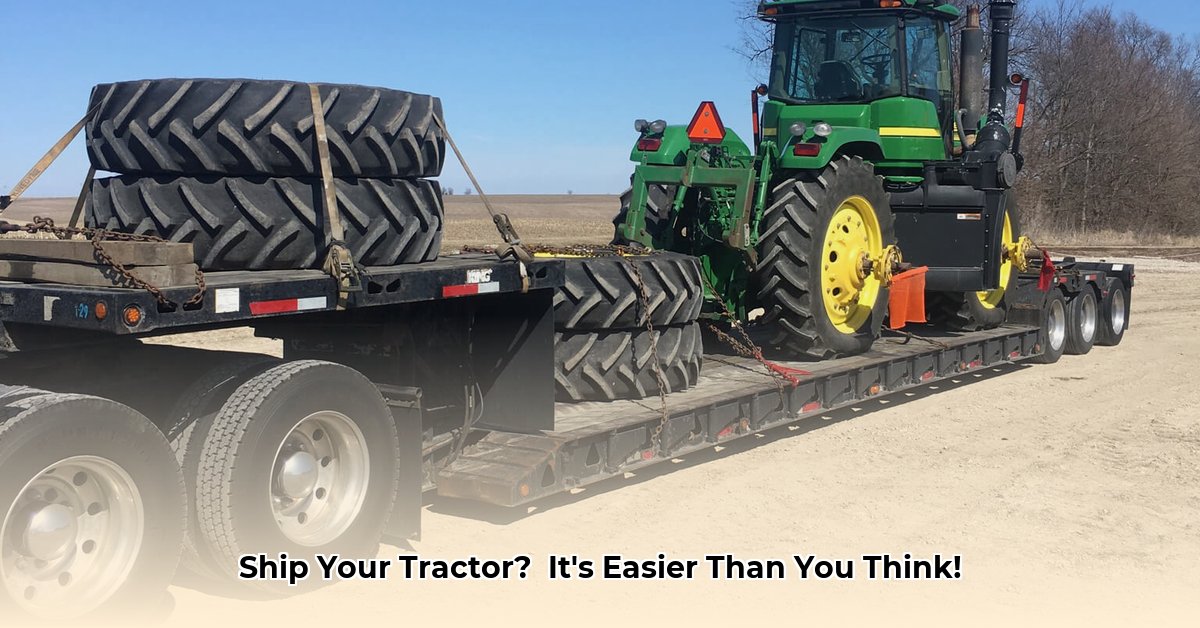
Moving a tractor can seem daunting, but with careful planning, it's manageable. This guide provides actionable steps for safely and cost-effectively shipping your tractor, focusing on minimizing stress and maximizing efficiency. For more detailed cost analysis, check out this helpful resource on tractor shipping costs.
Planning Your Tractor Shipment
Before contacting any shippers, gather crucial information. Accurate measurements (length, width, height, and weight) are essential for obtaining accurate quotes. Precise origin and destination addresses are also vital, including any relevant landmarks for easier location. Taking photos of your tractor from multiple angles can expedite the quoting process and prevent misunderstandings.
Do you know the exact weight of your tractor and its attachments? This detail is critical for determining the appropriate transport method and associated costs. Unexpectedly high weight can significantly increase shipping expenses.
Finding the Right Transporter
Choosing a transporter is a vital step. Don't settle for the first quote you get. Thoroughly research potential carriers, comparing their services, pricing, insurance coverage, and experience with similar shipments. Here's a comparison table to help you:
| Factor | Important Considerations |
|---|---|
| Price | Obtain multiple quotes; compare pricing structures for transparency and avoid hidden fees. |
| Equipment | Does the carrier have trailers suitable for the size and weight of your tractor? |
| Insurance | Ensure adequate coverage for potential damage or loss during transit. |
| Reviews/Reputation | Check online reviews and seek referrals from other farmers. |
| Tractor Experience | Verify expertise in handling farm equipment for safe and efficient transport. |
| Licensing & Permits | Confirm the carrier holds all necessary licenses and permits for legal compliance. |
Remember to check online reviews on sites like Google, Yelp, and industry-specific forums. Word-of-mouth recommendations from other farmers can also be invaluable.
Preparing Your Tractor for Shipment
Proper preparation is key to preventing damage and minimizing risks. Think of it as preparing your tractor for a long and potentially bumpy journey. Here's a step-by-step checklist:
- Thorough Cleaning: Remove all mud, dirt, and debris to allow for easy post-transport damage assessment.
- Secure Loose Parts: Firmly secure all loose tools, attachments, and other items to prevent shifting during transit.
- Detach Unnecessary Attachments: Remove implements like plows or harrows to reduce weight, size, and the risk of damage.
- Fluid Drainage: Partially drain fuel tanks (adhere to fuel quantity regulations), hydraulic fluid, and engine oil to reduce weight and the risk of leaks.
- Protect Sensitive Areas: Cover vulnerable areas with protective material such as tarps or blankets for added protection against weather and scratches.
- Documentation: Take detailed photographs before shipping, noting the condition of your tractor for later reference.
Did you know that properly draining fluids can significantly reduce both shipping costs and the risk of leaks during transport? This seemingly small step can yield substantial benefits.
Choosing Your Transportation Method
Several options are available, each with its advantages and disadvantages:
- Open Trailers: Cost-effective for short distances and good weather, but offer minimal protection from the elements.
- Enclosed Trailers: More expensive but provide superior protection from weather and theft, ideal for long-distance shipments.
- Lowboy Trailers: Specialized trailers for oversized or heavy equipment, ensuring stability during transport.
Choosing the right method is crucial and depends on your specific needs, distance, budget, and weather conditions. Consult with your chosen transporter to make the best decision for your situation.
Monitoring and Receiving Your Tractor
Modern technology makes tracking simple. Many carriers offer GPS tracking, providing real-time updates on your tractor's location. While delays can occur, maintaining clear communication with your transporter is vital for addressing any issues proactively.
Upon arrival, conduct a thorough inspection before signing any paperwork. Carefully examine your tractor for any damage incurred during transit. Document all findings with photographs and videos, reporting any discrepancies immediately to the transporter and your insurance provider.
Have you considered the importance of clear communication with your chosen transporter? This is crucial for timely updates and efficient resolution of any potential issues during the shipping process.
Conclusion
Shipping a tractor successfully involves thorough planning, preparation, and the selection of a trustworthy transporter. By following these steps and prioritizing clear communication, you can ensure your valuable equipment arrives safely and efficiently, minimizing stress and optimizing costs. Remember, a well-planned shipment is a successful shipment.